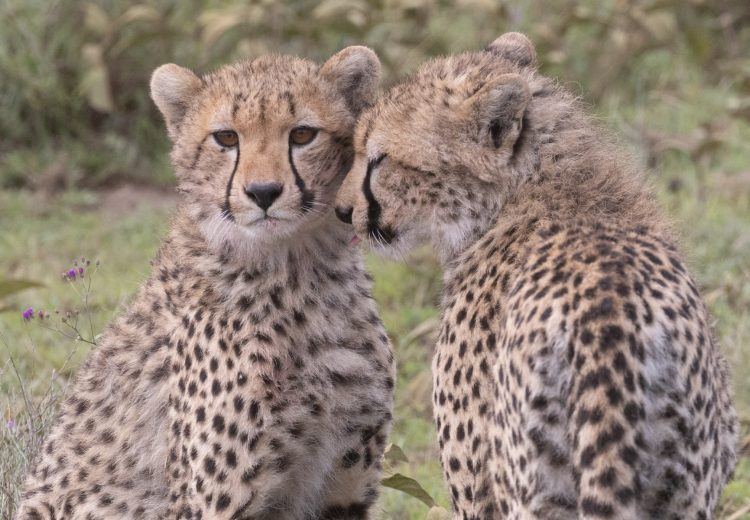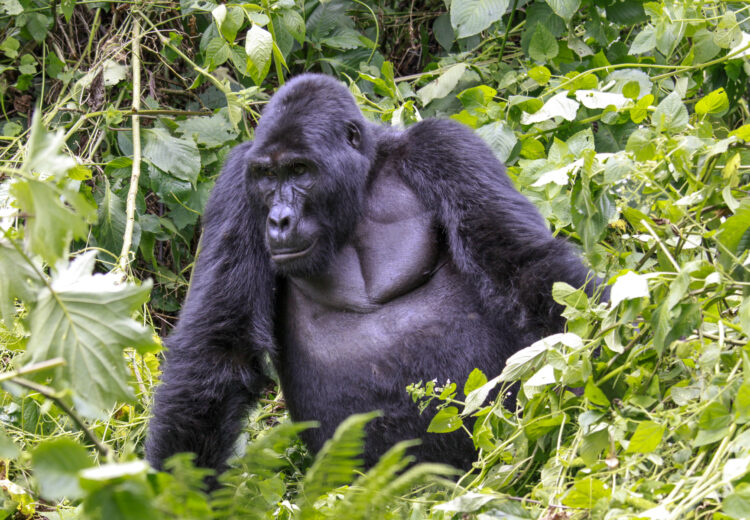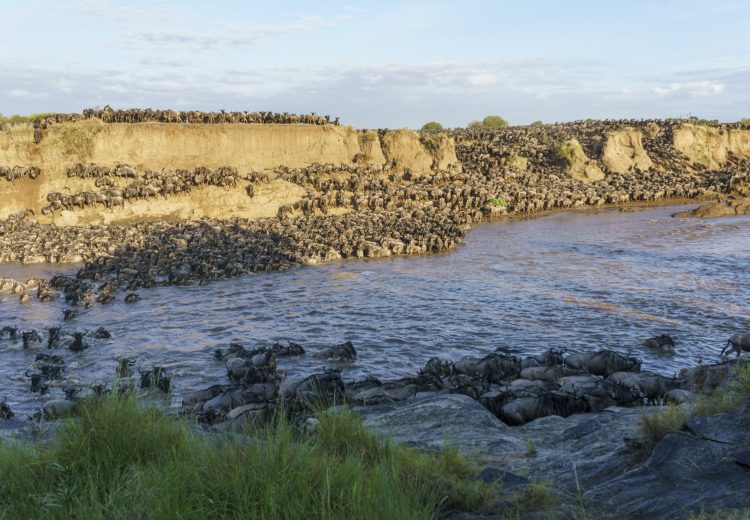Zambia
ZAMBIA: SOUTH LUANGWA – The Valley of Leopards and so much more



























































































































































































Large Spotted Genet seen on one of our night drives in South Luangwa (image by Inger Vandyke)

Clouds form over the Luangwa River to create a stunning sunset (image by Inger Vandyke)

A charismatic Crested Barbet sits on a log near its nesting hole (image by Inger Vandyke)

"Who are you?" a young Yellow Baboon sits in a tree and guarding his space in South Luangwa (image by Inger Vandyke)

A sleepy leopard wakes at sunset and gets ready for a night of prowling (image by Inger Vandyke)

Grey-crowned Cranes would have to be some one of Africa's most stunning and photogenic bird species (image by Inger Vandyke)

Found you! A male leopard with his Impala prey up an Ebony Tree during a night safari (image by Inger Vandyke)

A Southern Carmine Bee-eater rests on a mud bank near the Luangwa River (image by Inger Vandyke)

Although common, Laughing Doves can look very pretty up close (image by Inger Vandyke)

A Waterbuck trio in the ebony forest (image by Inger Vandyke)

Crayshaw's Zebras look stunning in the yellow savannah grasslands of South Luangwa (image by Inger Vandyke)

Stunning Southern Carmine Bee-eaters at their nesting hole on the banks of the Luangwa River (image by Inger Vandyke)

A flock of Southern Carmine Bee-eaters take a break from the frenetic pace of their breeding colony (image by Inger Vandyke)

African Porcupine on a night safari in South Luangwa (image by Inger Vandyke)

Eye level with a yawning hippo (image by Inger Vandyke)

A pair of Grey-crowned Cranes in a feeding flock (image by Inger Vandyke)

A Heuglin's Courser seen on a night safari in South Luangwa (image by Inger Vandyke)

Two Southern Carmine Bee-eaters argue over nesting space (image by Inger Vandyke)

A male lion at sunrise. King of South Luangwa's woodlands (image by Inger Vandyke)


"Eye spy with my little Eye" (image by Inger Vandyke)

A spectacular grazing pair of Grey-crowned Cranes (image by Inger Vandyke)

An elephant browsing mopane leaves (image by Inger Vandyke)

A baby elephant crosses the Luangwa River in the safety of its herd (image by Inger Vandyke)

Portrait of a Grey-crowned Crane panting in the heat (image by Inger Vandyke)

Portrait of a Pearlie. Pearl-spotted Owlets are one of the cutest and loudest owls in Africa (image by Inger Vandyke)

Gorgeous Lilian's Lovebirds taking a drink (image by Inger Vandyke)

Red-billed Oxpecker on a hippo with the golden waters of the Luangwa River behind (image by Inger Vandyke)

A Southern Red-billed Hornbill on a dead tree (image by Inger Vandyke)

A dazzle of Crayshaw's Zebras drinking from a pool filled with water hyacinth (image by Inger Vandyke)

An African Skimmer taking a drink in the river (image by Inger Vandyke)

The Southern Carmine Bee-eater population is so gargantuan that they give you lots of chances to practice birds in flight photography (image by Inger Vandyke)

Grey-crowned Cranes fly through a fiery Luangwa sunset to reach their night roost (image by Inger Vandyke)

"If I just hide my eye behing this hyacinth you won't see me" (image by Inger Vandyke)


A young Yellow Baboon on watch duty (image by Inger Vandyke)

A male leopard panting in the afternoon heat of South Luangwa (image by Inger Vandyke)

The journey of a river. A group of Thornicrofts Giraffes brave the crocodiles and cross a shallow stretch of the Luangwa River (image by Inger Vandyke)

"Ewwww!" A Red-biled Oxpecker cleaning up the wound on a hippo (image by Inger Vandyke)

Blech! A male lion tears out the intestine (?) of its young Wildebeest prey (image by Inger Vandyke)

A baby Vervet Monkey sitting in front of a hippo skull (image by Inger Vandyke)

A pretty male Bushbuck in the mopane woodlands of South Luangwa (image by Inger Vandyke)

A pair of elderly male African buffalos (image by Inger Vandyke)

Close up of a cheeky Vervet Monkey (image by Inger Vandyke)

Impalas sharing their drinking hole with a flock of butterflies (image by Inger Vandyke)

An African Jacana gets out of the way of two hippos moving through its water hyacinth pool (image by Inger Vandyke)

South Luangwa's ebony forests are like gardens of eden, particularly when they are visited by the park's resident elephant herds (image by Inger Vandyke)

A herd of African Buffalos in the red dust of sunrise (image by Inger Vandyke)

A solo Southern Carmine Bee-eater rests at the entrance of its nesting hole, with tail splayed (image by Inger Vandyke)

A hippo baby takes a swim with its mum (image by Inger Vandyke)

An African Skimmer comes into land on the shore of the Luangwa River (image by Inger Vandyke)

Portrait of a male Yellow Baboon (image by Inger Vandyke)

A young male lion wanders through the parched woodland of South Luangwa (image by Inger Vandyke)

A pair of Grey-crowned Cranes near Mfuwe (image by Inger Vandyke)

Carmine pair at their breeding colony (image by Inger Vandyke)


The Three Musketeers (image by Inger Vandyke)

A journey of Thornicroft's Giraffes crossing the Luangwa River (image by Inger Vandyke)

A Grey Heron braves the shallows of the Luangwa River which is home to hippos and crocodiles (image by Inger Vandyke)

"This hippo back is MINE!" (image by Inger Vandyke)

Reflections of a herd of Impala drinking in a pool (image by Inger Vandyke)

For a vegetarian, a hippo sure has huge teeth! (image by Inger Vandyke)

Close up of a Red-billed Oxpecker trying two work out if that hippo wound needs his attention (image by Inger Vandyke)

A hippo family in the hyacinth (image by Inger Vandyke)

A pair of Southern Ground Hornbills exchanging nesting material (image by Inger Vandyke)

A pair of Red-billed Oxpeckers having a chat on a hippo back (image by Inger Vandyke)

Up close with a hairy hippo snout (image by Inger Vandyke)

Red-billed Oxpecker pair on the back of a hippo (image by Inger Vandyke)

There are few sights more magical than the last light of day in Africa (image by Inger Vandyke)

Thousands of Southern Carmine Bee-eaters swarm the skies near one of Africa's largest nesting sites for this species (image by Inger Vandyke)

A White-fronted Bee Eater with its lunch of a bee! (image by Inger Vandyke)

When Spotted Hyena's yawn, they look like they have a toothy smile! (image by Inger Vandyke)

Dramatic cloud-filled sunset over the Luangwa River (image by Inger Vandyke)

The Luangwa River is home to a plethora of water birds of which White-crowned Lapwings are one. Look at those wing spurs! (image by Inger Vandyke)

"I'm the boss of this pool!" (image by Inger Vandyke)

A Puku mother with its fawn (image by Inger Vandyke)

Water splashes from the mouth of a hippo during an aggression display (image by Inger Vandyke)

Close up with a Meves's Starling (image by Inger Vandyke)

"Really? Why do you have to walk over me while I sleep?" (image by Inger Vandyke)

A gorgeous Puku fawn takes a break near its mother (image by Inger Vandyke)

A young elephant grazing on herbaceous plants (image by Inger Vandyke)

Southern Carmines in flight (image by Inger Vandyke)

A solo Southern Carmine Bee-eater at the roost near its nesting area (image by Inger Vandyke)

Eye to eye with one of South Luangwa's hippos (image by Inger Vandyke)

Smiley Yellow Baboon (image by Inger Vandyke)

Egyptian Goose taking a bath in the shallows of the Luangwa River (image by Inger Vandyke)

Elephant crossing. This isn't a bad traffic jam on safari (image by Inger Vandyke)

Sleepy sunset lion in Luangwa (image by Inger Vandyke)

A Yellow Baboon with its leucistic baby. Leucism is a strong feature of South Luangwa's Yellow Baboons and it's quite common to see white ones (image by Inger Vandyke)

Even leopards have to crash out before a night of hunting (image by Inger Vandyke)

A gorgeous tiny Four-toed Elephant Shrew seen on a night safari in South Luangwa (image by Inger Vandyke)

Who knew that the sweat of a hippo is red? And that he has a foamy tear? (image by Inger Vandyke)

Flap-necked Chameleons are largely nocturnal and always special to see on night safaris (image by Inger Vandyke)

Portrait of a Crayshaw Zebra in a dazzle (image by Inger Vandyke)

An elephant family begins to cross the Luangwa River (image by Inger Vandyke)

The elephants of South Luangwa can be remarkably tame, giving you a chance to capture that iconic elephant-eye shot (image by Inger Vandyke)

"Will you get off my nose so I can drink?" (image by Inger Vandyke)

A majestic male lion at sunrise in South Luangwa (image by Inger Vandyke)

One of South Luangwa's elephant bulls raises up on its hind legs to feed (image by Inger Vandyke)

In the early light a young male lion poses in the parched mopane woodland of South Luangwa after wandering through swathes of dead red leaves (image by Inger Vandyke)

Herds of elephants regularly cross the Luangwa River (image by Inger Vandyke)

An African Skimmer flies past semi-submerged hippos in the Luangwa River (image by Inger Vandyke)

"I don't know what is more annoying! This pesky hyacinth weed or that obsessive Red-billed Oxpecker!" (image by Inger Vandyke)

Although they are common, Lilac-breasted Rollers are almost always on a photographer's wishlist (image by Inger Vandyke)

Red-necked Spurfowl at sunset (image by Inger Vandyke)

A stunning male Waterbuck in the herbal vegetation at the edge of the ebony forest (image by Inger Vandyke)

Close up of a hippo eye (image by Inger Vandyke)

Hippos facing off at sunset (image by Inger Vandyke)

A cheeky Vervet Monkey (image by Inger Vandyke)

A pair of Red-billed Oxpeckers holding their own as a hippo tries to get them off by splashing water at them! (image by Inger Vandyke)

A young Black-headed Heron surveys its riverine world (image by Inger Vandyke)

A silhouetted Southern Carmine Bee-eater in the sunset of the Luangwa River (image by Inger Vandyke)

A spectacular male Bateleur in flight (image by Inger Vandyke)

A pair of beautiful Impalas inside the Ebony forests of South Luangwa (image by Inger Vandyke)

A young African Skimmer flying over the Luangwa River (image by Inger Vandyke)

A Slender Mongoose approaches a pool to drink (image by Inger Vandyke)

A wary herd of African Buffalo at sunrise (image by Inger Vandyke)

A lone bee-eater basking in the late afternoon sun at its nesting colony (image by Inger Vandyke)

Mother hippo nudging her baby in the Luangwa River (image by Inger Vandyke)

"This hyacinth pool is all MINE!" (image by Inger Vandyke)

A beautiful Heuglin's Courser at sunrise (image by Inger Vandyke)

Cookson's Wildebeest in the beautifully contrasting mopane woodland of South Luangwa (image by Inger Vandyke)

Nom nom nom! A male lion enjoys a breakfast of a young Wildebeest (image by Inger Vandyke)


Silhouette of a Yellow Baboon (image by Inger Vandyke)

Spotted Thick-knee (image by Inger Vandyke)

A journey of Thornicroft's Giraffes crossing the Luangwa River (image by Inger Vandyke)

A Southern Ground Hornbill with nesting material. South Luangwa still has many large trees so thankfully these magnificent birds are thriving there (image by Inger Vandyke)

South Luangwa's varied landscapes include mopane and ebony woodland. Here a young male lion wanders through the Mopane (image by Inger Vandyke)

Storm skies sheltering the sunset in Luangwa (image by Inger Vandyke)

A beautiful female Kudu in South Luangwa's ebony forests (image by Inger Vandyke)


Sunrise catches the hair on the edge of a buffalo's ears (image by Inger Vandyke)

The magical ebony woodlands of South Luangwa (image by Inger Vandyke)

One of Mfuwe Lodge's elephant visitors, wandering through the lodge reception to reach the native mango tree in the lodge grounds (image by Mfuwe Lodge)

Of all the birds you can see in South Luangwa, Southern Carmine Bee-eaters are a firm favourite of everyone! (image by Inger Vandyke)

Powerful and extremely agile, a male leopard scales an Ebony Tree to reach the prey he stashed in the upper branches (image by Inger Vandyke)

It doesn't get any better than photography in a red sky dawn in Luangwa (image by Inger Vandyke)

A meeting of Yellow-billed Oxpeckers on a buffalo's back (image by Inger Vandyke)

Grey-crowned Crane in flight (image by Inger Vandyke)

During night drives it is possible to see a swathe of nocturnal mammals including Scrub Hare (image by Inger Vandyke)

A male leopard looking singularly unimpressed by the heat of Africa (image by Inger Vandyke)

Marsh Sandpiper on the move in the shallows of the Luangwa River (image by Inger Vandyke)

A Hamerkop wades through an algae-filled pool searching for breakfast (image by Inger Vandyke)

Hippo showing off his 'flip top head' (image by Inger Vandyke)

Portrait of a Southern Ground Hornbill with nesting material (image by Inger Vandyke)

A male leopard takes a break at the base of an Ebony tree after stashing his prey of an Impala in the upper branches of the tree (image by Inger Vandyke)

The steep slopes of the Luangwa Riverbanks are hard to navigate if you are a baby elephant. It's better to stumble down them in the dust (image by Inger Vandyke)

Portrait of a Thornicroft's Giraffe with a Red-billed Oxpecker (image by Inger Vandyke)

Storm cells brewing over the Luangwa River (image by Inger Vandyke)


Backlit Yellow Baboon (image by Inger Vandyke)

Can you ever photograph too many bee-eaters? (image by Inger Vandyke)

Impalas wander through the magical Ebony forests of South Luangwa. At first light they are like a photographer's wonderland (image by Inger Vandyke)

A pair of African Skimmers in flight over the Luangwa River (image by Inger Vandyke)

South Luangwa is not only a haven for leopards, it is also very well known for its lions (image by Inger Vandyke)

The Southern Carmine Bee-eater is South Luangwa's most abundant bee-eater species. What a bird to see in great numbers! (image by Inger Vandyke)

A Crested Barbet at its nesting hole (image by Inger Vandyke)

Spectacular mass breeding area of Southern Carmine Bee-eaters (image by Inger Vandyke)


Hippo adorned with water hyacinth (image by Inger Vandyke)

African Grey Hornbill (image by Inger Vandyke)

A baby Yellow Baboon keeps watch from its mothers back (image by Inger Vandyke)

A shy Vervet Monkey appears from a gap in an ancient Ebony tree (image by Inger Vandyke)

African Buffalo with pesky oxpeckers (image by Inger Vandyke)

Full frontal portrait of a Plains Zebra (image by Inger Vandyke)

Sunset reflections of a hippo in the Luangwa River (image by Inger Vandyke)

A Red-billed Oxpecker tries to 'clean' an open wound on the snout of a hippo (image by Inger Vandyke)

Pretty White-fronted Bee Eaters are just one of South Luangwas 730 or so bird species (image by Inger Vandyke)

Cute little White-fronted Plovers are a regular resident of the Luangwa River shorelines (image by Inger Vandyke)

A yawning leopard at dusk (image by Inger Vandyke)

A trio of African Pied Kingfishers take a break between fishing (image by Inger Vandyke)

When the afternoon heat gets a little too much it's time for a snooze - but lions always sleep with their eyes half open (image by Inger Vandyke)

Guineafowls on the move (image by Inger Vandyke)

Reflections of an African Skimmer (image by Inger Vandyke)

A pair of Plains Zebra grazing in the savannah grasses (image by Inger Vandyke)

Portrait of a Helmeted Guineafowl (image by Inger Vandyke)

The orange glow of the setting sun, through the woodland bushes of South Luangwa (image by Inger Vandyke)

A Puku gets caught in a momentary dust storm near the Luangwa River (image by Inger Vandyke)

A small dazzle of Crayshaw's Zebras graze on the drying grasses in the bed of a Luangwa River tributary (image by Inger Vandyke)

A flock of Marabou Storks in a drying pool with eels that they were enjoying for breakfast (image by Inger Vandyke)

White-fronted Bee Eaters with its bee lunch on a thorny acacia (image by Inger Vandyke)

A Red-billed Oxpecker 'lucks out' on potential feeding targets as the back of an Impala is too clean! (image by Inger Vandyke)

Reflection of a male Impala drinking from a pool (image by Inger Vandyke)

Peekaboo! (image by Inger Vandyke)
|
Sunday 19th October –
Thursday 30th October 2025 Leaders: Inger Vandyke and highly skilled local naturalist driver-guides |
12 Days | Group Size Limit 4 (full) |
|
Tuesday 19th October –
Saturday 30th October 2027 Leaders: Inger Vandyke and highly skilled local naturalist driver-guides |
12 Days | Group Size Limit 4 |
ZAMBIA: SOUTH LUANGWA WILDLIFE PHOTOGRAPHY TOURS WITH WILD IMAGES
Deep in southern Africa lies South Luangwa, Zambia’s foremost reserve that gives birth to the Great Rift Valley. South Luangwa is home to Africa’s largest concentration of leopards and these charismatic cats join a cast of diverse wildlife wonders in a myriad of landscapes that includes ebony and teak woodlands, oxbow lagoons, plains and the spectacular Luangwa River with its ancient “Wafwas” (dry river courses). Join us as the summer of South Luangwa intensifies and the water sources of the reserve begin to dry up forcing the reserve’s wildlife to gather near the river and lagoons, creating spectacular photographic opportunities on almost every safari.
Going on safari in South Luangwa is like stepping back into a time where human encroachment has remained at a low ebb and the truly wild still reigns supreme. South Luangwa is home to an extremely broad variety of mammals including the endemic Thornicrofts Giraffe, Crawshay’s Zebra and Cookson’s Wildebeest. Elephants are a regular feature of our safaris here and if we are lucky we may encounter one of South Luangwa’s resident packs of African Wild Dogs during our tour. Combine this with over 400 species of birds and South Luangwa is truly one of Africa’s most inspiring and beautiful photography destinations.
Why travel to South Luangwa with Wild Images?
Our tour is special. We offer a stunning combination of morning, afternoon and night safari drives alongside hide photography, allowing you to capture a comprehensive portfolio from different perspectives and shooting angles.
These hides are regularly used by National Geographic, BBC and Discovery Channel for numerous photographic shoots and the making of wildlife documentaries.
Many companies offer inexpensive photography tours to South Luangwa, and they stay at budget lodges. We have personally selected our lodges for their incredible wildlife in three of the reserve’s core areas – South Luangwa, Nsefu and Mfuwe, allowing for maximum wildlife viewing and an unrivalled diversity of experiences.
Our safari vehicles include high seats, camera rests and bean bags. We have limited this experience to just four guests, meaning a professional photographer will be travelling with you on every safari.
Travelling deep into the more remote parts of the reserves means we avoid much of the heavier vehicle traffic in areas visited by larger, less expensive camps.
During sunrise and sunset safaris, we will be looking for renowned Luangwa species, including leopards, lions and wild dogs. On some evenings, we will also go on night safaris where we may see other wildlife treasures like Flap-necked Chameleons, Four-toed Senghis (elephant shrews), Large-spotted Genet and nocturnal birdlife.
Our tour will visit during the height of the Southern Carmine Bee-eater breeding season when these gorgeous birds are at a mass nesting site on the banks of the Luangwa River. Unique to our lodge is a mobile hide that is either parked on the beach in front of this colony or constructed on a boat in the river, depending on the water levels during our visit. The birds have become used to it being there. As such, they go about their frenetic daily lives, flying to and from nesting holes, roosting on the nearby beach and engaging in gentle courtship displays, all within metres of where you will sit taking photographs.
From our specialist photography hides, we will also get to eye-level with hippos and watch herds of elephants cross the Luangwa River, sometimes at close range.
NSEFU
South Luangwa’s exclusive Nsefu region is sandwiched between the eastern shores of the Luangwa River and the park border. Lying in a remote part of the reserve, it is home to an extremely high number of leopards, and they will feature heavily on our safari searches in this part of the tour.
We wil be staying at Nsefu lodge, nestled high on a riverbank overlooking a sweeping bend of the Luangwa River. Nsefu is the oldest and most loved lodge in Nsefu, offering premier wildlife viewing on game drives that might see us encountering the Chicehli pride of lions, Spotted Hyena and a many other creatures, including Puku (the woolly relation of impalas), baboons, elephants, impala, African Buffalo and a plethora of birds. A small lodge that accommodates just 12 guests, it is possible to sit and eat Lemon Drizzle cake watching herds of elephants cross the river below your viewpoint during a siesta from safaris in Nsefu!
SOUTH LUANGWA
From Nsefu we will transfer into the core area of South Luangwa where we will enjoy four nights at the exclusive Kaingo Lodge. Kaingo means Leopard in the local Nyanja language, which is fitting as this camp has a long history with these incredible felines. The name itself came about due to the resident female leopard, Goldie, who liked the idea of Kaingo so much, she took up residence in one of the chalets. Kaingo has created a very special safari experience on a series of regularly graded bush tracks. Here, we will divide our time between safari drives and spending time in the lodge’s custom-built photography hides that allow us to get to eye level with the Luangwa River hippos, wildlife and the resident breeding colony of Southern Carmine Bee-eaters.
From this side of South Luangwa, we have witnessed troupes of baboons with their leucistic youngsters, feeding in the Mopane woodland. South Luangwa has an unusually high number of white baby baboons and watching them being cared for by their families is a highlight. We’ve photographed journeys of Thornicrofts Giraffes braving the crocodiles lurking in the shallows to cross the Luangwa River and seen huge herds of African Buffalo from our safaris at Kaingo. We’ve watched lions protecting their tiny cubs and seen leopards sleeping in trees. Aside from the breath-taking bee-eater colony, other avian highlights have included African Skimmers, Goliath Herons, and at one point we sat fascinated while we watched a pair of Southern Ground Hornbills exchanging ‘gifts’ of nesting material in a gentle display of courtship. Due to a large number of established trees, South Luangwa has become a haven for ground hornbills, which are under threat from pollution, logging and agriculture elsewhere. It is encounters like these that make safaris in South Luangwa so unique and fascinating.
During our stay at Kaingo we will also enjoy night safaris where we may see some of South Luangwa’s less known nocturnal creatures including genets, Flap-necked Chameleon, Four-toed Senghi and bush babies.
Like Nsefu, Kaingo is also hidden away on the edge of the Luangwa River, taking just twelve guests. The central point of the lodge is a Chitenge building housing the restaurant, library and bar carved out of a thousand-year-old Lead Wood tree. Breakfasts are served on a pontoon overlooking the river where we may see cruising crocodiles, herds of elephants or fishing kingfishers while we enjoy a sumptuous breakfast. The atmosphere at Kaingo is truly very special.
MFUWE
Located close to the park entrance, the pretty region of Mfuwe is one of the better areas of South Luangwa to see the charismatic African Wild Dog. While sightings are never guaranteed, seeing a pack of these fascinating apex predators is always memorable, especially if we come across them on a hunt. Mfuwe has several lagoons that feature resident hippos lounging around in great swathes of water hyacinth plants. They are occasionally joined by the resident Crayshaw’s Zebras and a raft of waterbirds all seeking respite from the African heat.
In Mfuwe, we will also visit the Luangwa River, where we may see herds of elephants crossing the shallows or flocks of feeding Grey-crowned Cranes, one of Africa’s most sought-after birds to photograph.
As a wonderful finale to our time in South Luangwa, we will enjoy two nights at Mfuwe Lodge during a time when their wild mango trees begin to drop fruit. This curious and unique phenomena entices a resident herd of elephants to wander through the lodge reception to reach the dropping fruit on the ground and enjoy their own ‘lodge lunch’. While this situation is never guaranteed, our tour is timed to visit when the likelihood of elephants visiting is at their highest, and to see them wandering through a building is a truly unforgettable experience.
Mfuwe is situated close to the park gates, allowing us to maximise our time in South Luangwa before our flight to Lusaka where our tour will end.
Join us in untamed and unspoilt South Luangwa for a truly memorable photography safari.
Accommodation
NSEFU LODGE
As a welcome to our tour we will enjoy four nights at the renowned Nsefu Camp, situated in arguably the best location in all of South Luangwa. Perched high on a bank overlooking a large bend in the Luangwa River, the atmosphere of this iconic lodge is reminiscent of yesteryear. We will enjoy a welcome dinner overlooking the river where we may see herds of elephants crossing or coming to drink at sunset. The rooms are large rondavel style with open air bathrooms and unique ‘bed air conditioners’ allowing you to cool off in the heat of the day during a siesta.
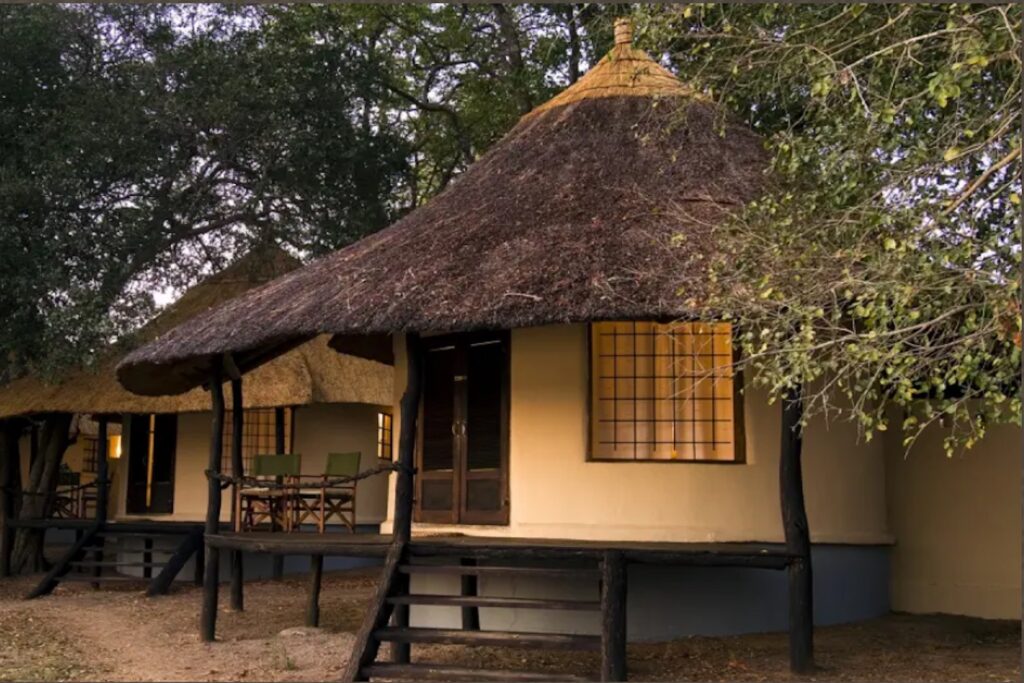
Historic Nsefu Camp is situated at the edge of the Luangwa River, occupying the most prestigious viewpoint in the entire reserve (image by Nsefu Camp)
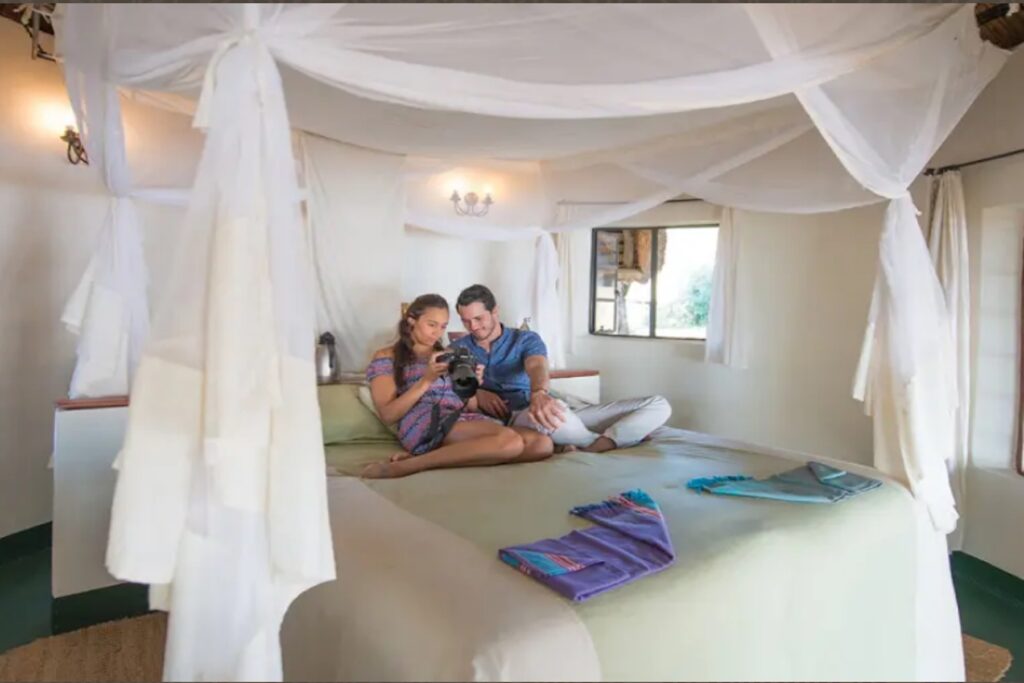
The spacious rondavel style rooms at Nsefu Camp (image by Nsefu Camp)
KAINGO CAMP
Overlooking the Luangwa River deep within the prime area of the South Luangwa National Park, Kaingo’s relaxed, personal and friendly atmosphere offers its guests fantastic game-viewing opportunities within an area of incredible beauty and varied terrain. Kaingo’s chalets were designed with the sole purpose of transporting you safely into the world of the Luangwa without a single distraction, nestled discretely apart on the banks of the river. The large centrally located open-sided “Chitenge” includes a dining area, library and Kaingo’s renowned thousand-year-old lead-wood bar.
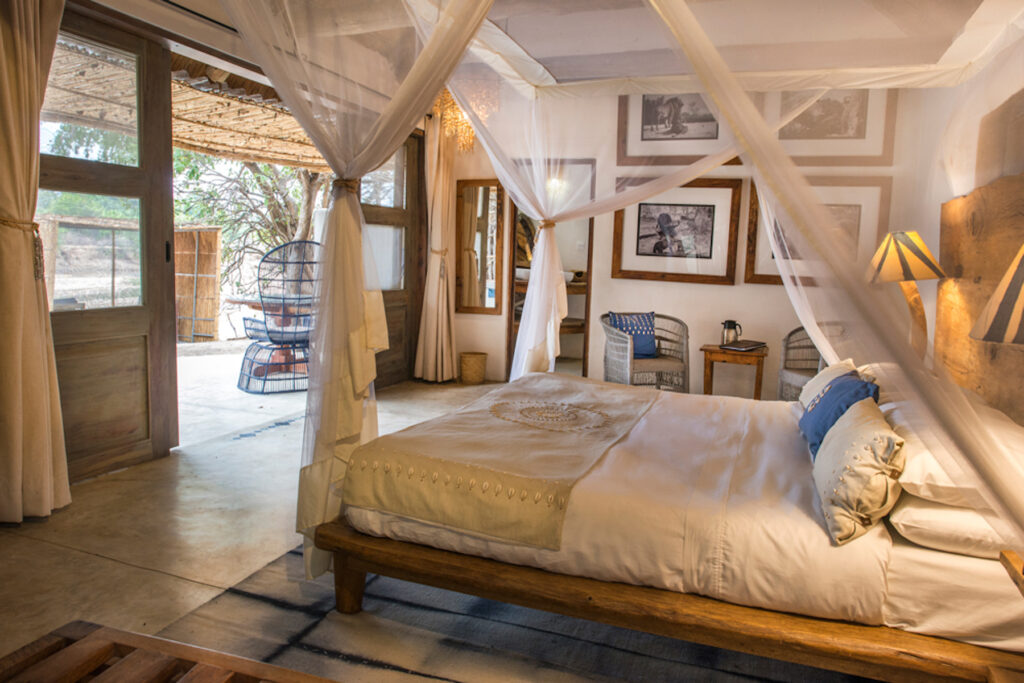
Rooms at Kaingo feature private balconies overlooking the Luangwa River (image by Kaingo Camp)
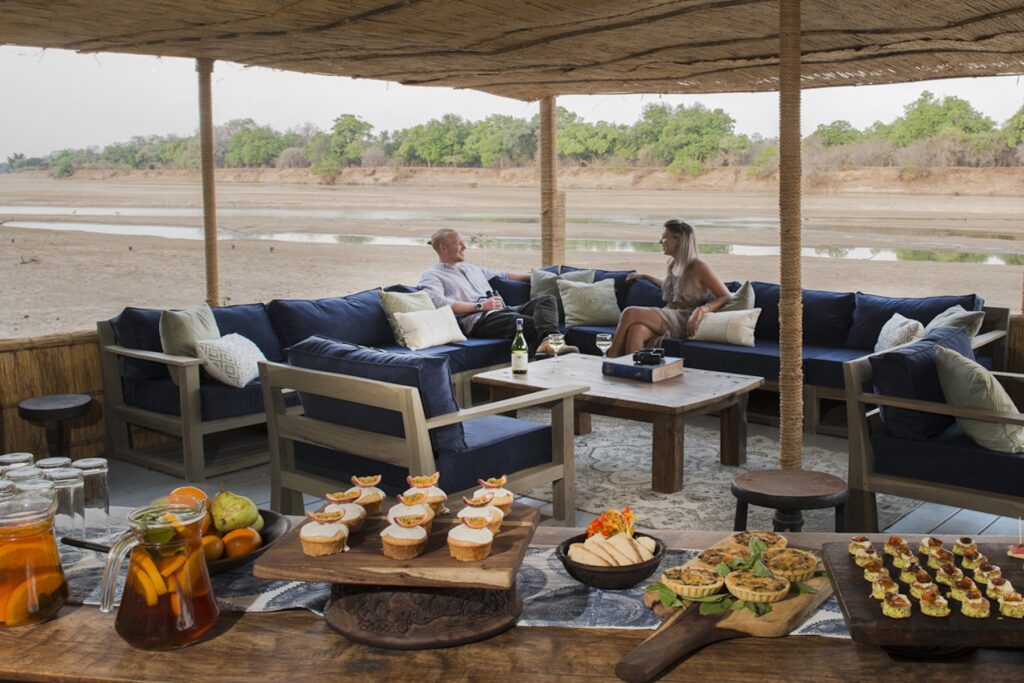
Kaingo’s wonderful pontoon lounge where you can dine at water level with some of South Luangwa’s amazing river wildlife (image by Kaingo Camp)
MFUWE LODGE
Set around two lagoons, shaded by a canopy of ebony and mahogany trees, Mfuwe Lodge is the ideal place to end our safari in South Luangwa.
The open plan reception, lounge, dining, and bar areas overlook two lagoons and the wallowing hippo and thirsty wildlife will keep you enthralled. 18 air-conditioned chalets are scattered around the gardens and secluded verandas outside each provide a lovely vantage point for the comings and goings. Inside, each chalet has a comfortable sitting room, imperial King or twin beds, and a spacious en suite bathroom with walk-in shower.
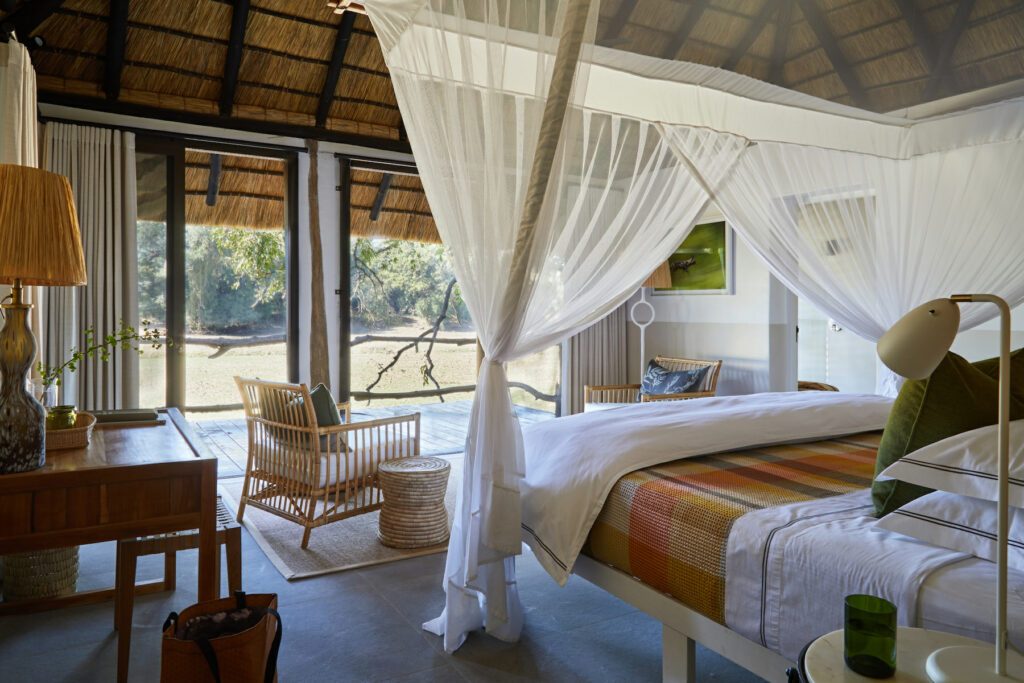
The spacious, air-conditioned rooms at Mfuwe Lodge (image by Mfuwe Lodge)
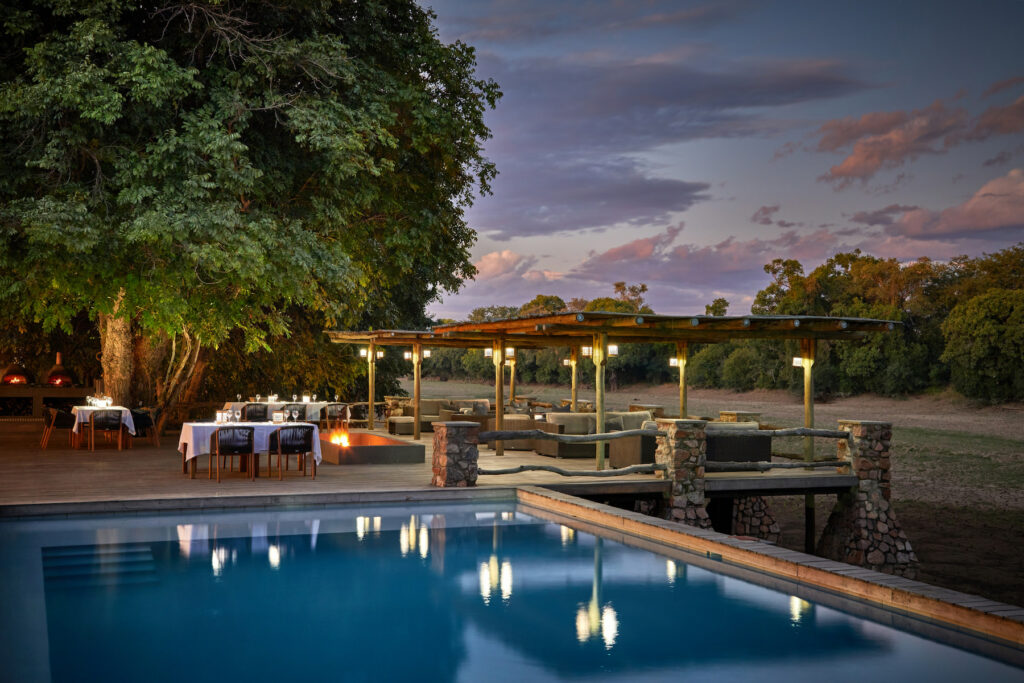
Dine under a blanket of a million stars in Mfuwe’s restaurant which looks out over a scenic lagoon (image by Mfuwe Lodge)
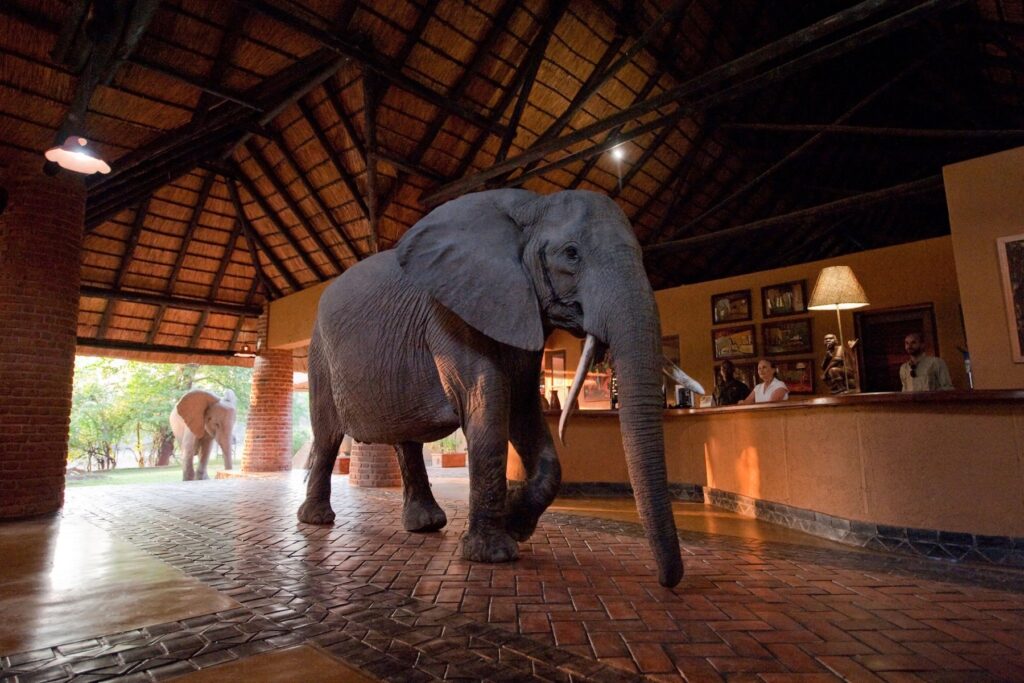
One of Mfuwe Lodge’s elephant visitors, wandering through the lodge reception to reach the native mango tree in the lodge grounds (image by Mfuwe Lodge)
Road Transport
The safari drives in Mfuwe and Nsefu sectors may be rough at times depending on the park sector we are travelling through on safari. Our safari vehicles are open-topped and open-sided allowing for plenty of space to store your camera backpacks. The seating configuration is two photographers per row for most safaris.
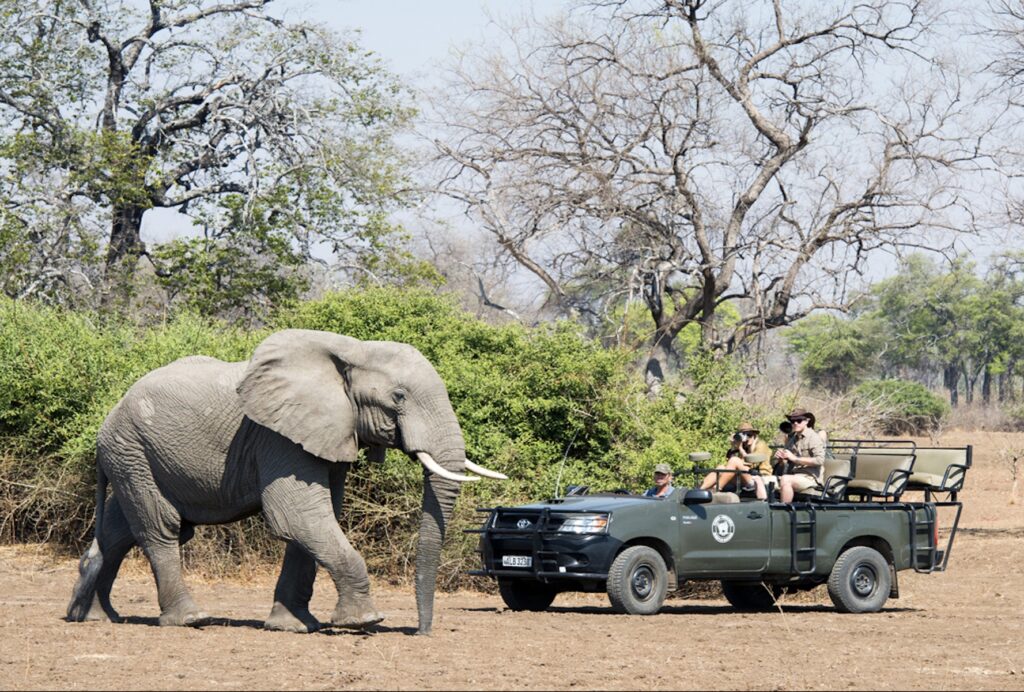
Open-sided and open-topped, our safari vehicles in South Luangwa are ideal for photography (image by Kaingo Camp)
Walking
Minimal, as one can only leave the vehicle for walking to the hides or ‘marking one’s territory’ as the driver guides so charmingly put it. The walking is mostly on flat ground between your lodge accommodation and our safari vehicles.
Climate
Most days in South Luangwa will be warm or hot, dry and sunny or overcast, or a mixture.
Photographic Equipment
If you use a full-frame DSLR or mirrorless camera for wildlife photography, you should bring telephotos (and, if need be, converters) that will cover the range of 100-600mm (even more if you like to photograph small to medium-sized birds). Most mammal images in South Luangwa will be taken at between 200-400mm. You will also find a wide-angle lens of around 24mm good for landscape photography, while focal lengths up to 70mm can be good at river crossings and other occasions. (There will be almost no opportunities to use a macro lens.)
You can also get great photographic results in Zambia’s South Luangwa with a good-quality bridge camera. It will be best if it has an optical zoom of 18-20x or more, combined with a reasonable wide angle at the other end of the zoom range.
If you would like to talk about suitable equipment, please contact our office. We will be happy to advise you.
Photography Hides
Our spacious photography hides in South Luangwa have been custom built to obtain the best vantage points for photographing iconic species like hippopotamus and elephants.
The hide at the Southern Carmine Bee-eater nesting site can either be situated on a beach next to the river, or if water levels are higher, on a floating boat.
The hippo hide is adjusted in accordance with the water levels of a pool that lies at the confluence of the Luangwa and Mwamba Rivers. It never dries out so it acts as a regular home to a boisterous, noisy group of several hippo families who jostle for the prime real estate in this pool to lounge and look after their young. It is a magnificent place to practice your action photography with these charismatic creatures as they go about their daily lives.
The following videos allow you to gain a glimpse of life inside our photographic hides in South Luangwa.
Photographic Highlights
- An unparalleled safari experience in one of Southern Africa's most prolific biodiversity hotspots. South Luangwa is at the terminus of the Great Rift Valley
- Morning, afternoon and evening safaris in open-roofed, open-sided safari vehicles that allow for maximum wildlife viewing
- Specialist hide photography sessions in hides that are regularly used by National Geographic, BBC and Discovery Channel for numerous photographic shoots and the making of wildlife documentaries
- South Luangwa has Africa's highest concentration of leopards
- Visit one of the largest nesting colonies of Southern Carmine Bee-eaters in Africa
- Our tour happens at a time when the resident elephant herd may walk through the lodge reception in Mfuwe in search of wild mangoes in the lodge grounds
- We may see one of South Luangwa's packs of African Wild Dogs
- Small group of just four photographers means that you will have a professional photography guide on every safari
OUTLINE ITINERARY
- Day 1: Our tour begins at Kenneth Kaunda Airport in Lusaka as we check in for our flight to Mfuwe. Arriving in Mfuwe we will transfer to our lodge for our first afternoon safari in the exclusive Nsefu sector of South Luangwa
- Days 2-4: Morning and afternoon safaris at Nsefu
- Day 5: After our last morning safari in Nsefu, transfer to Kaingo for an afternoon safari
- Days 6-8: Morning, afternoon and evening safaris along with hide photography sessions in South Luangwa's core area
- Day 9: After our last morning safari in South Luangwa's core area, transfer to Mfuwe in time for our first afternoon safari
- Day 10: Morning and afternoon safaris at Mfuwe
- Day 11: After a final morning safari we will leave for Mfuwe Airport for our flight to Lusaka where our tour will end.
To see a larger map, click on the square-like ‘enlarge’ icon in the upper right of the map box.
To see (or hide) the ‘map legend’, click on the icon with an arrow in the upper left of the map box.
To change to a satellite view, which is great for seeing the physical terrain (and for seeing really fine details by repetitive use of the + button), click on the square ‘map view’ icon in the lower left corner of the ‘map legend’.
ZAMBIA: SOUTH LUANGWA WILDLIFE PHOTOGRAPHY TOUR:
PRICE INFORMATION
Wild Images Inclusions: Our tour prices include surface transportation, accommodations, meals and reserve entrance fees.
Our tour prices also include these flights: Lusaka-Mfuwe-Lusaka
Tips/Gratuities are not included. We suggest you allow around US$250-300 per person.
Deposit: 20% of the total tour price. Our office will let you know what deposit amount is due, in order to confirm your booking, following receipt of your online booking form.
TO BOOK THIS TOUR: Click here (you will need the tour dates)
2025: confirmed price $13950, €13320, £10950, AUD22180. Lusaka/Lusaka.
2027: provisional price $13950, €13320, £10950, AUD22180. Lusaka/Lusaka.
Single Supplement: 2025: $3450, €3290, £2700, AUD5480.
Single Supplement: 2027: $3450, €3290, £2700, AUD5480.
If you are travelling alone, the single supplement will not apply if you are willing to share a room and there is a room-mate of the same sex available.
This tour is priced in US Dollars. Amounts shown in other currencies are indicative.
Air Travel To & From The Tour: Our in-house IATA ticket agency will be pleased to arrange your air travel on request, or you may arrange this yourself if you prefer.
ZAMBIA: SOUTH LUANGWA WILDLIFE PHOTOGRAPHY TOUR: DETAILED ITINERARY
Day 1
Our tour starts at Kenneth Kaunda Airport in Lusaka where we will check in for our flight to Mfuwe. After a short flight of just over an hour we will arrive in Mfuwe in time for checking into our lodge and enjoying our first afternoon safari in the exclusive Nsefu sector of South Luangwa.
Days 2 to 4
Nsefu camp beckons you to slow down and soak in the superb views from its sweeping bend of the Luangwa River. With a busy waterhold and outstanding game viewing areas, Nsefu has everything you could want in an Africa safari. Nsefu safaris will thrill you in this unspoiled piece of heaven for the next three days. It is home to South Luangwa’s highest concentration of leopards. The daily elephant crossing will have you looking forward to lunch for more than just the delicious meal. Evenings are best enjoyed in a comfortable armchair with a slice of lemon drizzle cake as you watch lions and leopards lapping at the lagoon.
Day 5
After our last morning safari in Nsefu we will transfer to Kaingo for an afternoon safari.
Days 6 to 8
We will spend these three full days exploring the core section of South Luangwa from our wonderful Kaingo Lodge, with its abundance of large mammals and diverse birdlife.
Game-viewing starts from camp as we are in the park and our guides are quick to react to the alarm calls of Baboons or impalas. They last approximately three and a half hours and are offered morning and afternoon. Morning game drives leave around sunrise, with a tea break on the route. While evening game drive departs after afternoon tea, with a stop for a sundowner around sunset time, the drive will continue into the night to observe the nocturnal animals. Travelling around South Luangwa in purpose-built Toyota Landcruisers with open sides and roofs, we will be able to get up close to all kinds of photogenic wildlife, including the endemic Thornicroft’s Giraffes, Crayshaw’s Zebras and Cookson’s Wildebeest plus a huge variety of birds.
Kaingo is special, thanks in large part to their photographic hides. They’re an incredible experience for anyone who loves wildlife. They allow our guests to get close to the animals, enabling you to watch them undisturbed in their natural environment. That said, they are well equipped to take care of our photographers – the lodge can provide specialist bean bags, dust covers and charging facilities.
These hides are guaranteed to get you close enough to the wildlife to take a whole host of stunning photos – in complete safety.
Days 9 and 10
After a final morning safari in Kaingo we will transfer to our final lodge of the tour in South Luangwa, Mfuwe Lodge. Here we will enjoy morning and afternoon safaris. During lunch we will hope to see Mfuwe’s resident herd of elephants wandering through the lodge reception to feast on wild mangoes in the lodge grounds
Day 11
On the final day of our tour we will enjoy an early morning safari at our lodge before we transfer to Mfuwe airport for our flight to Lusaka where our tour will end.
We can arrange a transfer for you to any Lusaka hotel on request.
Please Note: Day rooms or overnight stays in Lusaka and international airport transfers can be arranged, according to your requirements, on request.
OTHER WILDLIFE PHOTOGRAPHY TOURS IN AFRICA BY WILD IMAGES
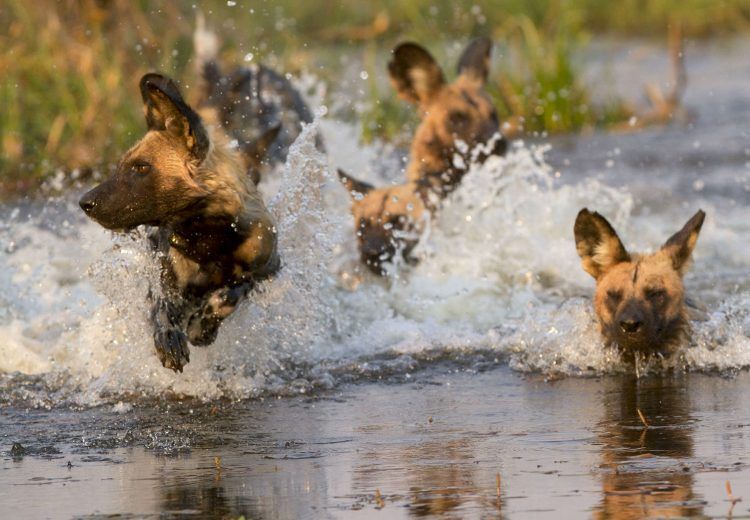
Botswana & The Okavango
November 2025
BOTSWANA: WILDLIFE SPECTACULAR – The photographic wonders of the Okavango and Chobe
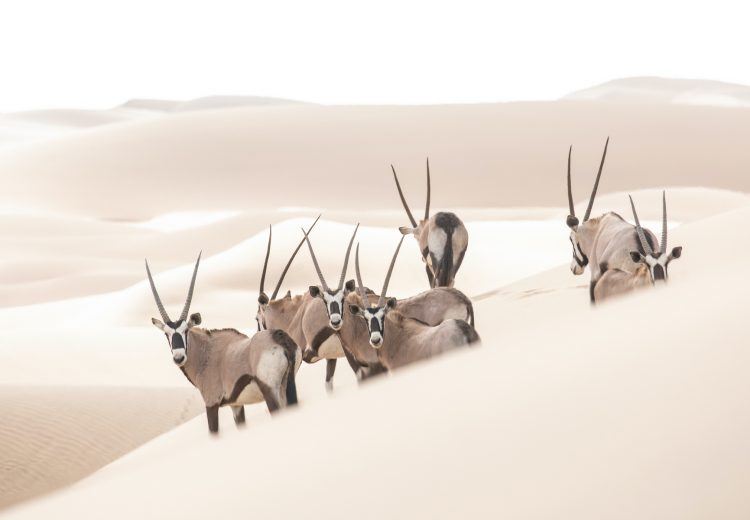
South Africa
July-August 2026




























































































































































































